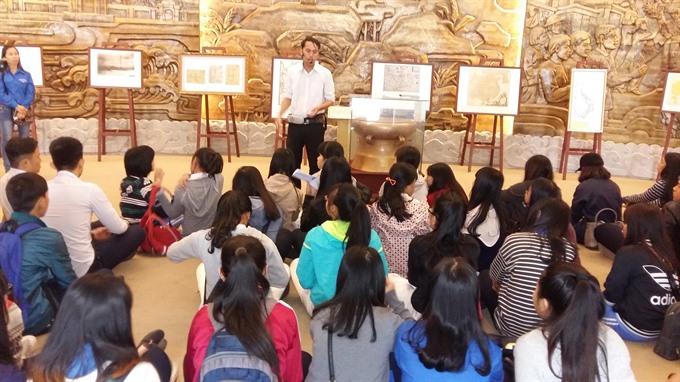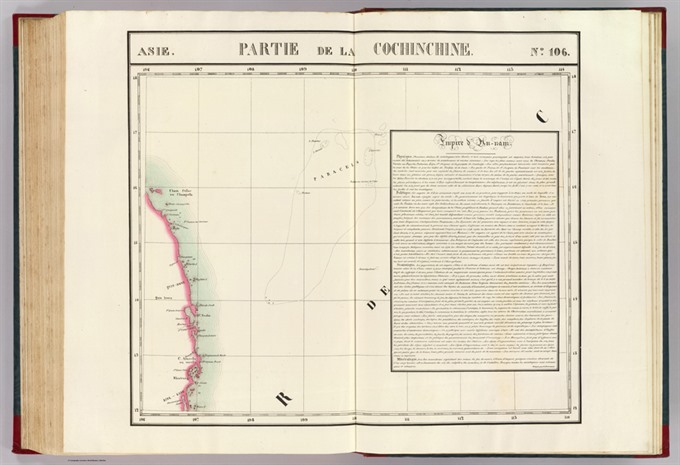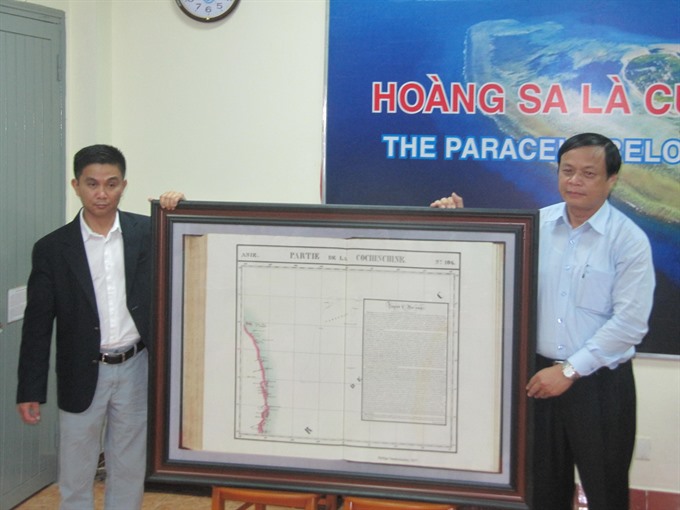 |
| Students
of Đà Nẵng join a field tour to study the history of the Hoàng Sa
(Paracels) and Trường Sa (Spratly) Archipelagos at the city’s Museum. |
The map, 1.2m wide and 0.85m high, is one of the most detailed maps indicating clearly Vietnam’s sovereignty over the Hoàng Sa (Paracels) Islands. The map is part of many that Thắng has collected in Europe and the US since 2012.
The map, drawn by Philippe Vandermaelen, founder of the Belgium Royal Geographical Society, indicates that the central coast of Vietnam stretched from the 12th parallel (in the area of what is Khánh Hòa Province now, to the 16th parallel (Quảng Nam Province now).,
The names used in the map are Bink-Knag, or Nhia Trang (Nha Trang City), and Champella (Cù Lao Chàm or Chàm Island).
The map also shows Hoàng Sa (Paracels) Islands offshore between the 14th and 17th latitudes, and from the 109th to 113th longitudes.
The Hoàng Sa (Paracels) Islands have been drawn in great detail accuracy, including Pattles, Duncan in the west; Tree and Lincoln, Bocher au dessas de l’eau in the east and Triton in the southwest near the 16th parallel, Investigateur in the south in the 14.5 parallel, and marking of a sea area 5m-10m deep to Quin Hone (Quy Nhơn City in Bình Định Province now) in the 14th parallel.
“I’ve spent a lot of time collecting old maps that state or identify Vietnam’s sovereignty over the Hoàng Sa (Paracels) and Trường Sa (Spratly) Archipelagos. I wish to contribute more documents to the Hoàng Sa Museum in Đà Nẵng City,” Thắng said.
“I have collected and donated 150 old maps, of which 80 Chinese maps indicate the frontier of Southern China is Hainan Island, and 50 indicate that the Paracels Archipelago belongs to Vietnam,” Thắng said.
Thắng said the Pattie De La Conchinchine was a rare map printed early in the 19th century in great precision, using western written names of the islands in the Hoàng Sa Archipelago.
He said Conchinchine, a name used to indicate the central region of Annam (a French protectorate encompassing the central region of Vietnam), was part of Annam, and Hoàng Sa (Paracels) was under sovereignty of Vietnam at least from 19th century onwards.
Thắng, who is president of the Institute for Vietnamese Culture and Education (IVCE) in the US, said the 1827-printed Pattie De La Conchinchine also identified coastal islands of Cham Collac ou Champella (or Cù Lao Chàm, or Chàm Island off the coast of Hội An city), and P.Canton ou Cacitam (Cù Lao Ré, or Lý Sơn Island off the coast of Quảng Ngãi Province).
Võ Ngọc Đồng, Chairman of the Hoàng Sa (Paracels) Island District, said the map was a highly precious document for Hoàng Sa Archipelago.
“It’s a treasure for the Hoàng Sa Islands. The map will enrich the store of documents and artifacts related to history of Hoàng Sa Islands, and facilitate further studies on Vietnam’s islands,” Đồng said.
Over three years (2012-2014), Thắng had collected 150 old maps published between 1826 and 1980 in England, America, France, Germany and Scotland from antique shops in the US, England and Poland.
Among the maps and atlases donated to the Đà Nẵng Museum are two Postal Atlas Maps of China published by the Directorate General of Posts, Ministry of Transportation of the Republic of China in 1919 (consisting of 49 maps), in 1933 (29 maps) and one Atlas of the Chinese Empire, published by the China Inland Mission in 1909 (23 maps).
None of these three volumes list the Paracels and Spratlys in the maps and index pages.
Trần Đức Anh Sơn, deputy director of the Đà Nẵng-based Institute for Socio-Economic Development (ISED), said the collection of old maps was significant evidence that the two archipelagoes belonged to Vietnam.
"We can classify that the collection comprises three kinds of maps: 68 old maps of China showing that China did not have the Paracel and Spratlys islands; six maps that indicate those islands belong to Vietnam; five maps of the Southeast Asian region that show Paracel and Spratly archipelagoes under Vietnamese sovereignty," Sơn said.
He said the map collection had been displayed during the ‘Sea and Islands Week’ held nationwide last year.
Lý Sơn Island, 30km offshore from Quảng Ngãi Province, still preserves the Âm Linh Pagoda, a place of worship for seamen dispatched to the Paracel Islands since the 17th century during the reign of the Nguyễn Dynasty.
A museum of the two archipelagoes displays over 200 ancient documents and 100 objects proving that the Paracel and Spratly archipelagoes belong to Vietnam.
In 2015, Da Nang presented a Certificate of Merit to Trần Thắng for his donation of a 150 map collection. Last year, at a conference on Conflict in the South China Sea (called East Sea by Vietnam) at the Yale University in Connecticut, the US, Thắng also displayed a collection of 40 ancient maps indicating the Hoàng Sa (Paracel) Islands belong to Vietnam.
The Hoàng Sa Museum, under construction on the Đà Nẵng coast, stores collections of maps, documents, photos and objects on the Hoàng Sa and Trường Sa archipelagoes.
In its adjusted urban master plan until 2030 with a vision until 2050, the city will develop the Hoang Sa (Paracel) Archipelago on 30,500ha.
The history of Đà Nẵng and its relationship with the Hoàng Sa (Paracel) Archipelago was introduced into secondary and high school textbooks last year.
 |
| The original Pattie De La Conchinchine. |
 |
| Trần Thắng(L) donates an 1827-printed map, Pattie De La Conchinchine, drawn by Belgium cartographer Phillippe Vandermaelen (1795-1869), to the Hoàng Sa District’s People’s committee on January 10. |

Leave your comment on this story